Fujifilm XF1 Review
Fujifilm XF1 Performance - How well does it take pictures?
Choosing a digital camera is all about results: Getting the image quality you need and photographs the way you like them. Compact digital cameras generally have it tough because they suffer from small sensors and limited controls. The Fuji XF1 is made to address these two concerns while maintaining the size of a compact camera.
The XF1 uses a 2/3" BSI-CMOS sensor which is slightly larger than most premium compact digital cameras. With the exception of the Sony Cybershot DSC-RX100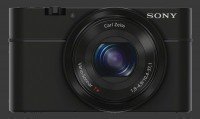
Sony Cybershot DSC-RX100, cameras with larger sensors are considerably bigger. This gives it an edge in low light which is stretched further because of its ultra-bright F/1.8 lens. This quickly dims to F/2.8 at 35mm, F/4 at 50mm and F/4.9 from 62mm onwards.
Image noise is absent from images at ISO 100 and at ISO 200 which we suspect is the native sensitivity of the XF1. Noise increases slowly and stays unobtrusive until ISO 800, making 12" x 9" prints clean and crisp. ISO 1600 gets a noticeable jump in noise and the XF1 starts to ignore the Shadow Tone parameter from then on. This results in noisy-but-usable mid-size prints. Image quality suffers at ISO 3200 which can make noisy-but-usable 4" x 6" prints.
Noise reduction is very aggressive. There are 5 levels to choose from and we recommend choosing Low if you like details in your images. Even this applies too much reduction at moderately slow shutter-speeds. This is why the indoor crops appear much softer than gallery images shot at the same ISO sensitivity.
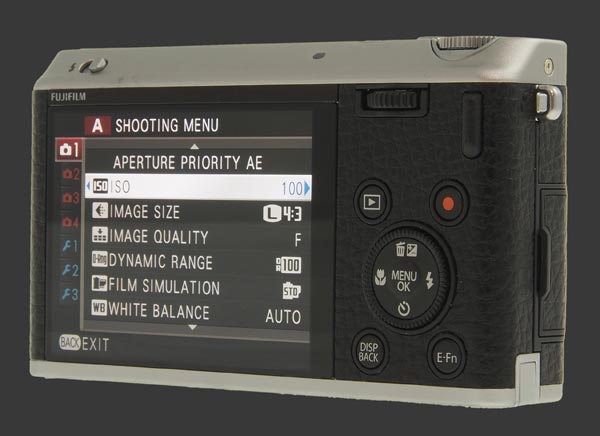
Colors of the Fuji XF1 are good but despite numerous Film Simulation Modes and parameters, they never get very accurate. Provia gives the best results with Saturation at -1. Image contrast has h a rather steep tone-curve. Tuning down Shadow Tone and Highlight Tone to Medium Soft makes things better and increases the dynamic-range kept in JPEG images. The XF1 supports RAW capture which lets users perform their own processing and trade these issues for extra effort.
Automatic white-balance is average. It can produce perfectly neutral colors but sometimes falls short, leaving scenes with a slight yellowish cast both indoors and outdoors. Presets can correct this easily and Custom WB works perfectly.
Metering of the Fuji XF1 is incredibly reliable. This camera requires less exposure-compensation than most cameras and manages to produce bright images without clipping major highlights. This produces more print-ready images but small highlights get occasionally clipped.
The dynamic-range of this digital camera is exceptional for its sensor-size. At full resolution, it can handle up to 2 stops more than the typical compact. At 6 MP the XF1 can handle up to 4 extra stops which is only matched by other Fuji compacts. Hover over the percentages below and watch what happens to highlights as the dynamic-range is increased.
- 100%

- 200%

- 400%

- 800%

- 1600%

Optically, the 25-100mm F/1.8-4.9 lens of the XF1 demonstrates the compromises taken. The lens shows strong softness all around the edges at F/1.8. It must be stopped down to F/5.6 to get some reasonable sharpness across the frame. Maximum sharpness is achieved at F/7.1 just before diffraction takes effect. Sharpness in the center is reasonable at all apertures and focal-lengths though.
As mentioned in the usability page of this review, optical distortion is high. The camera corrects for it in JPEG images but RAW shooters do not benefit from this and cannot correctly preview framing.
Optical distortion is high although it does not always appear! The XF1 actually corrects for distortion by internal processing and previews the corrected image. The instant review however does not. This is why, after shooting, the image shown is slightly wider and more distorted. What is shown makes into RAW files. Unfortunately, RAW shooters cannot preview the correct framing even if the camera is set to RAW only.
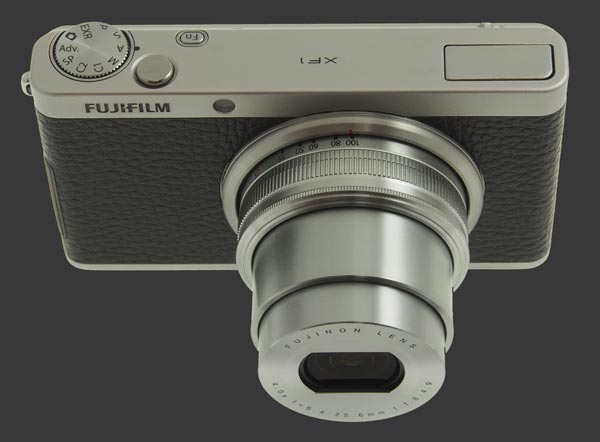
The Fuji XF1 uses the latest generation EXR-CMOS sensor which gives high-speed features including 7 FPS continuous drive at 12 MP or 11 FPS at 6 MP. The display however cannot keep up which makes continuous shooting unsuitable for action photography.
The XF1 is generally quite responsive except when writing images. Most buttons and dials operate instantly. Zooming is certainly ultra-fast and ultra-precise since it is done mechanically. The performance of this digital camera is characterized by the following measurements:
- Power On: 2 seconds with practice! Good.
- Autofocus: ¼ in good light to ¾ seconds in low light towards telephoto end. Under ½s mostly. Very good.
- Image Shutter-Lag: Instant. Excellent.
- Video Shutter-Lag: 2s. Very slow.
- Black Out: About ¼s. Excellent.
- Shot-to-Shot speed: 1¼s. Average.
- Time-to-first shot: 3s with practice. Below average.
- Playback: Around 1s to enter or exit. Average.
- Power Off: Under 2s with practice. Good.
The Fuji XF1 has a very fast shutter-lag and autofocus system. It slows down in low-light but remains faster than most fixed-lens cameras. Only shot-to-shot speeds are slow compared to similar premium compacts. Video shooters will be disappointed by the glacial 2s it takes to start recording video, plus you cannot even see what you are framing ahead of time.
Battery-life of the XF1 is short at 300 shots-per-charge, according to the CIPA measurement standard. This is even more true if shooting in low-light where exposure-times are long and the XF1 slows down to apply noise-reduction. Avoiding the built-in flash extends this a bit but a second battery is highly recommended to make it through long days of shooting.
Fujifilm XF1 Performance - How well does it shoot video?
The Fuji XF1 shoots videos up to 1920x1080 at 30 FPS with stereo sound. Lower resolutions of 1280x720 and 640x480 are also available at 30 FPS. There are three high-speed video modes: 640x480 @ 70 FPS, 320x240 @ 120 FPS and 320x112 @ 200 FPS. High-speed videos are recorded without sound and played back at 30 FPS, giving the impression of slow-motion.
There are two autofocus modes for video:
- Center which locks focus on the center of the first frame. This causes things away from the locked distance to be out-of-focus but is completely predictable.
- Continuous which constantly adjusts focus as video is recorded. The camera spends most of the time trying to focus in this mode and large portions of videos may end up out of focus.
While video can be recording in any exposure mode, it is always performs automatic exposure.
There is no video mode on the Fuji XF1 and so the camera is never ready to shoot video. For this reason, pressing the Video Record button starts recording after a two second delay. Also, unless shooting at VGA or QVGA resolution, the LCD does not preview of correct framing for video because it does not know when it will be asked to shoot video. Optional HD guidelines are available but it takes several steps to enable them.
The mechanical zoom is obviously usable while recording video. In Center focus mode, it is possible this will throw the video permanently out-of-focus so beware. In Continuous focus mode, the camera takes a while to reestablish focus but eventually does.
Video quality of the Fuji XF1, when things are in focus at least, is very good. Frames are detailed and motion is rendered smoothly. The automatic exposure system generally maintains a good level of exposure.
Fujifilm XF1 Conclusion
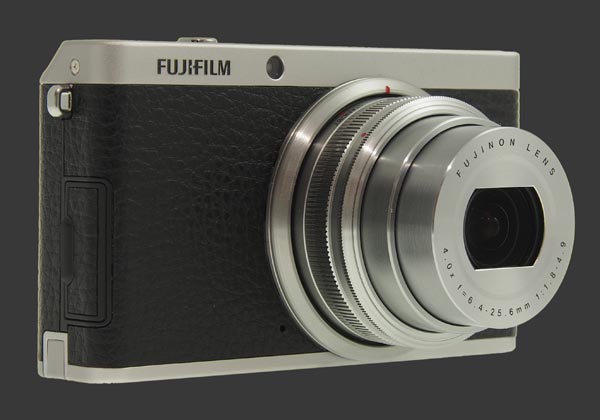
The Fuji XF1 is the ultimate miniaturization of Fuji's premium X series. It delivers some powerful capabilities in a pocketable size with a great number of controls, including its unique sliding mechanical lens. The Fuji XF1 is really a pleasure to use, something which can rarely be said of such a small camera.
The 12 megapixels EXR-CMOS sensor of the XF1 delivers competitive image quality with low image-noise and exceptional dynamic-range. Metering is excellent too. Colors and white-balance are satisfactory as well. What tarnishes image quality for the XF1 is overly aggressive noise reduction and severe edge softness at moderate-to-wide apertures. This keeps it from producing images which match the quality of top premium compacts.
The LCD display has good visibility but is not so accurate. Exposure is rarely previewed correctly and framing does not match what makes it into RAW files. This complicates things for those hoping to perform their own RAW conversions.
This is one of the most responsive compact digital cameras around. The autofocus system is very quick for Contrast-Detect and shutter-lag is virtually inexistent. Only aspect slow shot-to-shot speeds can get in the way of photography. Video shooters are faced with too many usability issues and therefore we cannot recommend the XF1 for video.
If you shoot JPEG images and never print larger than 12" x 9" though, the softness and noise-reduction will not have much of an impact and you can easily get great images from the Fuji XF1.
 |
Please Support Neocamera
All information on Neocamera is provided free of charge yet running this website is a huge endeavor. Purchases made via affiliate links found throughout the site help keep it running and up-to-date. There is no additional cost to you, so please consider buying via these links to our affilates:
If you found any information on this site valuable and did not purchase via our affiliate links, please considering donating via PayPal:
Any amount will be greatly appreaciated. Thank you for your support!
Fujifilm XF1 Highlights
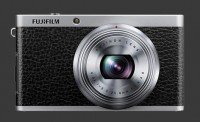
Sensor-Size: 9 x 7mm

Actual size when viewed at 100 DPI
| 12 Megapixels Fixed Lens | ISO 100-3200 |
| 4X Mechanically Linked Ultra-Wide Optical Zoom | Shutter 1/2000-30s |
| Built-in Stabilization | Full manual controls, including Manual Focus |
| 7 FPS Drive, 8 Images | Custom white-balance |
| 1920x1080 @ 30 FPS Video Recording | Spot-Metering |
| 3" LCD 460K Pixels | Lithium-Ion Battery |
| Secure Digital Extended Capacity |
Updates
2024.04.03

Fujifilm X-T5 Review
Newest Fujifilm flagship boasting a 40 MP APS-C sensor, 5-axis IBIS with 7-stop efficiency, 15 FPS continuous drive, 6.2K Video capture, dual control-dials and dual SDXC UHS-II slots in a sturdy weatherproof and freezeproof body.
2023.11.20

Best Digital Cameras of 2023
Find out which are the Best Digital Cameras of 2023. All the new Mirrorless Digital Cameras from entry-level to high-end professional.
2023.07.10

Fujifilm X-H2 Review
40 Megapixels APS-C Hybrid Mirrorless Digital Camera with 7-stop IBIS. Fastest shutter ever and 8K video capture. Large builtin EVF with 0.8X magnification and 5.8 MP, plus an Eye-Start Sensor. Packed with features and large number of controls in a weatherproof and freezeproof body.
2023.05.07

Sony FE 20-70mm F/4G Review
Review of the unique Sony FE 20-70mm F/4G lens. The optical zoom of this lens spans ultra-wide-angle and medium focal-length coverage, making it one of the most versatile Full-Frame lenses on the market.
2023.01.15

Huion Inspiroy Dial 2 Review
Review of the Huion Inspiroy Dial 2 tablet, a medium sized drawing surface with dual dials and customizable buttons. Connects via USB-C or Bluetooth 5.0 with Windows, Linux and Android support.
2022.12.08

How to Pack for a Photo Trip
Find out how to pack for a travel photography trip, carry your gear safely while meeting airline regulations.
2022.11.13

Best Digital Cameras of 2022
The best digital cameras of 2022. A short list of the most outstanding models in their respective categories. Choose one for yourself or as a gift.
2022.09.21

Pentax DA* 60-250mm F/4 SDM Review
Review of the Pentax DA* 60-250mm F/4 SDM, the constant-aperture telephoto zoom with the highest zoom-ratio on the market.
2022.09.20

Pentax DA* 50-135mm F/2.8 SDM Review
Review of the Pentax DA* 50-135mm F/2.8 SDM, the lightest professional telephoto zoom native to the K-mount.
2022.09.10

Pentax DA* 11-18mm F/2.8 DC AW Review
Review of the Pentax DA* 11-18mm F/2.8 DC AW, the widest professional ultra-wide zoom native to the K-mount.
2021.11.24

50 Gifts Under $50 For Photographers in 2021
50 Gifts photographers will love. All for under $50 USD. 2021 Edition.
2021.11.17

Best Digital Cameras for 2021
Neocamera shows which are the very best Digital Cameras for 2021 in every category: Mirrorless, DSLR, Premium Compact, Ultra-Zoom and Rugged.












